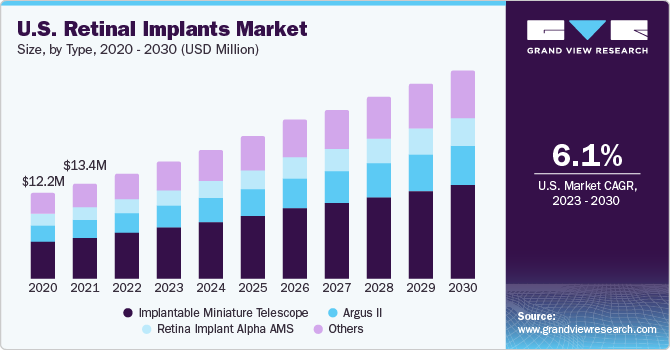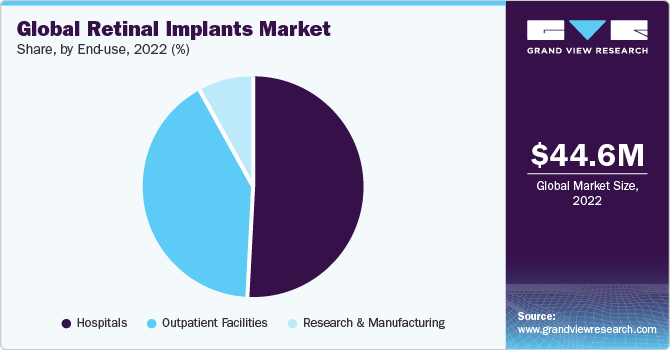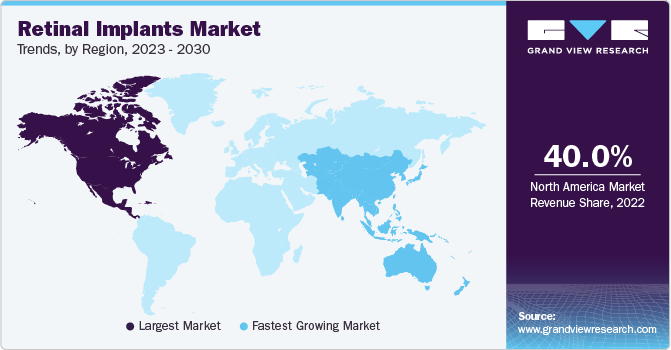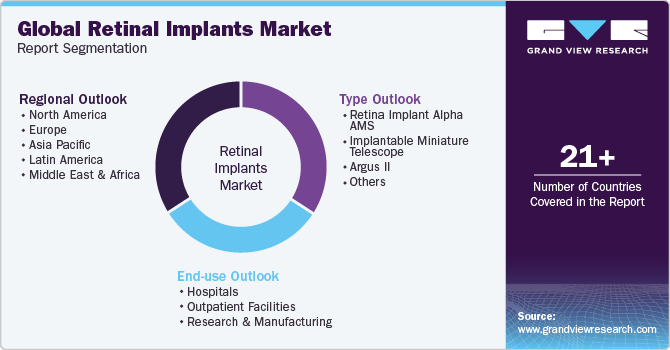- Home
- »
- Medical Devices
- »
-
Retinal Implants Market Size, Share & Growth Report, 2030GVR Report cover
![Retinal Implants Market Size, Share & Trends Report]()
Retinal Implants Market Size, Share & Trends Analysis Report By Type (Retina Implant Alpha AMS, Implantable Miniature), By End-use (Hospitals, Outpatient Facilities), By Region, And Segment Forecasts, 2023 - 2030
- Report ID: 978-1-68038-728-5
- Number of Report Pages: 60
- Format: PDF, Horizon Databook
- Historical Range: 2018 - 2021
- Forecast Period: 2023 - 2030
- Industry: Healthcare
Retinal Implants Market Size & Trends
The global retinal implants market size was estimated at USD 44.6 million in 2022 and is expected to expand at a compound annual growth rate (CAGR) of 8.6% from 2023 to 2030. The ability to restore vision, the growing senior population, and the increasing prevalence of target illnesses drive demand for retinal implants. The market is expanding owing to the rising frequency of retinal disorders worldwide. Blindness or loss of vision may result from many illnesses. Age-related macular degeneration (AMD), diabetic retinopathy, and retinitis pigmentosa are a few of the most prevalent retinal disorders.

The COVID-19 pandemic significantly impacted the market for retinal implants. Retinal implants are normally performed in the hospital environment; therefore, it becomes more difficult for patients to receive them. This decreased patient access to care, as many hospitals and clinics were compelled to restrict or stop non-essential services. Clinical studies for new retinal implants were also postponed by the pandemic for several reasons, including the necessity to prioritize COVID-19 research and the challenge of patient recruitment for clinical trials in the middle of a pandemic.
Approximately 1.1 crore people in India are expected to be affected by retinal abnormalities, while around one in three diabetics have some form of diabetic retinopathy, which is an eye-related consequence of the condition. The market for retinal implants is expanding, in part due to the rising global elderly population. Retinal illnesses are more common in this demographic, boosting the demand for retinal implants.
Research institutes are collaborating with pharmaceutical companies for the development of new and innovative retinal implants. Moreover, government funding for retinal implant research and development (R&D) is steadily rising, and the awareness of patients and healthcare professionals regarding retinal implants is growing. These are some of the key trends advancing the market.
Device Type Insights
Based on the device type, the market is segmented into retina implant alpha AMS, implantable miniature telescope, Argus II, and others. The implantable miniature telescope segment accounted for the largest revenue share of around 38% in 2022. The retina implants alpha AMS segment is expected to grow at the fastest CAGR of 9.13% during the forecast period. The high prevalence of AMD, a leading cause of blindness in older adults, creates a substantial patient pool seeking treatments such as IMTs. Ongoing technological advancements in IMT design and functionality can make these devices more effective and attractive to patients and healthcare providers.
During the projected period, substantial growth in the Argus II segment is anticipated. The primary purpose of the epiretinal implant Argus II is to treat retinitis pigmentosa. A highly prevalent condition affecting the retina is retinal pigments. As per the National Institute of Health in Europe and the U.S., one out of every 4,000 to 4,500 persons suffer from this eye disorder.
End-use Insights
Based on end-use, the market is segmented into hospitals, outpatient facilities, and research & manufacturing. The hospital segment accounted for the largest revenue share of over 50% in 2022. The hospital segment held the largest revenue segment in 2022, owing to most of the patients visiting private hospitals due to the availability of eye experts.

The hospital & outpatient facilities segments are expected to grow at the fastest CAGR of 8.8% during the forecast period. There is a rise in the number of independent eye hospitals across the globe. This trend is expected to continue during the forecast period owing to the availability of specialists, cost efficiency, and technologically advanced equipment.
Regional Insights
North America dominated the market and accounted for the largest revenue share of over 40% in 2022. The region has a strong and well-established pharmaceutical industry, which is a key driver of the market. Many leading pharmaceutical companies in the region are investing in the development of retinal implants, which is driving the growth of the market. The market is expanding because of the increasing number of product launches. In this region, significant innovations, technological improvements, partnerships, and agreements are being made. For instance, on September 6, 2021, U.S.-based MedTech business Cirtec Medical and Bionic Vision Technologies (BVT) announced their strategic alliance. Because of this collaboration, Cirtec gained a strategic share in Bionic and is likely to help that company further create and refine its newest retinal implants.

Asia Pacific is expected to advance at the highest CAGR of 9.01% during the forecast period. The region has experienced significant growth in healthcare expenditure, resulting in a greater investment in R&D activities concerning retinal implants. This has helped in the development of new and innovative products and technologies, boosting market growth. Conditions such as age-related macular degeneration (AMD) and retinitis pigmentosa (RP) are becoming more prevalent globally. Additionally, the population is rapidly getting older and consumers are becoming more aware of government policies. Furthermore, the healthcare infrastructure is undergoing modernization, while the medical tourism industry is rapidly expanding in developing economies such as China and India. Regional market expansion is also anticipated to be fueled by leading market participants spending more on healthcare in the public and private sectors to reach unexplored regions.
Key Companies & Market Share Insights
The market is very competitive, with several manufacturers holding a majority of the market share. For instance, in January 2018, Pixium Vision received approval from the U.S. FDA to initiate clinical trials for PRIMA, which is a sub-retinal implant. The implant was approved for practice in patients with atrophic dry Age-related Macular Degeneration (AMD). Product launches, approvals, strategic acquisitions, and innovations are just a few of the critical business strategies market participants use to maintain and grow their global reach. The market participants are constantly working towards new product development, M&A activities, and other strategic alliances to gain market avenues.
Key Retinal Implants Companies:
- Vivani Medical
- Pixium Vision
- Boston Retinal Implant Project
- Nano Retina
- Labtician Ophthalmics, Inc.
- LambdaVision, Inc.
- Bionic Vision Technologies
- Nidek Co., Ltd.
- Retina Implant AG
- Optobionics
- VisionCare Ophthalmic Technologies
Retinal Implants Market Report Scope
Report Attribute
Details
Market size value in 2023
USD 49.3 million
Revenue forecast in 2030
USD 87.9 million
Growth rate
CAGR of 8.6% from 2023 to 2030
Base year for estimation
2022
Historical data
2018 - 2021
Forecast period
2023 - 2030
Report updated
November 2023
Quantitative units
Revenue in USD million and CAGR from 2023 to 2030
Report coverage
Revenue forecast, company ranking, competitive landscape, growth factors, and trends
Segments covered
Type, end-use, region
Regional scope
North America; Europe; Asia Pacific; Latin America; MEA
Country scope
U.S.; Canada; UK; Germany; France; Italy; Spain; Denmark; Sweden; Norway; China; Japan; India; Australia; South Korea; Thailand; Brazil; Mexico; Argentina; Saudi Arabia; South Africa; UAE; Kuwait
Key companies profiled
Vivani Medical; Pixium Vision; Boston Retinal Implant Project; Nano Retina; Labtician Ophthalmics, Inc.; LambdaVision, Inc.; Bionic Vision Technologies; Nidek Co., Ltd.; Retina Implant AG; Optobionics; VisionCare Ophthalmic Technologies
Customization scope
Free report customization (equivalent up to 8 analyst’s working days) with purchase. Addition or alteration to country, regional & segment scope
Pricing and purchase options
Avail customized purchase options to meet your exact research needs. Explore purchase options.
Global Retinal Implants Market Report Segmentation
This report forecasts revenue growth at global, regional, and country levels and provides an analysis of the latest industry trends in each of the sub-segments from 2018 to 2030. For this study, Grand View Research has segmented the global retinal implantsmarket report based on type, end-use, and region:

-
Type Outlook (Revenue, USD Million, 2018 - 2030)
-
Retina Implant Alpha AMS
-
Implantable Miniature Telescope
-
Argus II
-
Others
-
-
End-use Outlook (Revenue, USD Million, 2018 - 2030)
-
Hospitals
-
Outpatient Facilities
-
Research & Manufacturing
-
-
Regional Outlook (Revenue, USD Million, 2018 - 2030)
-
North America
-
U.S.
-
Canada
-
-
Europe
-
UK
-
Germany
-
France
-
Italy
-
Spain
-
Sweden
-
Norway
-
Denmark
-
-
Asia Pacific
-
China
-
Japan
-
India
-
Australia
-
Thailand
-
South Korea
-
-
Latin America
-
Brazil
-
Mexico
-
Argentina
-
-
Middle East and Africa
-
Saudi Arabia
-
South Africa
-
UAE
-
Kuwait
-
-
Frequently Asked Questions About This Report
b. The global retinal implants market size was estimated at USD 44.6 million in 2022 and is expected to reach USD 49.3 million in 2023.
b. The global retinal implants market is expected to grow at a compound annual growth rate of 8.6% from 2023 to 2030 to reach USD 87.9 million by 2030.
b. North America dominated the retinal implants market with a share of 40% in 2022. This is attributable to high prevalence of degenerative conditions and technological advancements.
b. Some key players operating in the retinal implants market include Second Sight Medical Products, Inc.; Retina Implant AG; and VisionCare, Inc.
b. Key factors that are driving the market growth include rising prevalence of target diseases and growing demand for vision correction.
Share this report with your colleague or friend.
![gvr icn]()
NEED A CUSTOM REPORT?
We can customize every report - free of charge - including purchasing stand-alone sections or country-level reports, as well as offer affordable discounts for start-ups & universities. Contact us now
![Certified Icon]()
We are GDPR and CCPA compliant! Your transaction & personal information is safe and secure. For more details, please read our privacy policy.
We are committed towards customer satisfaction, and quality service.
"The quality of research they have done for us has been excellent."





